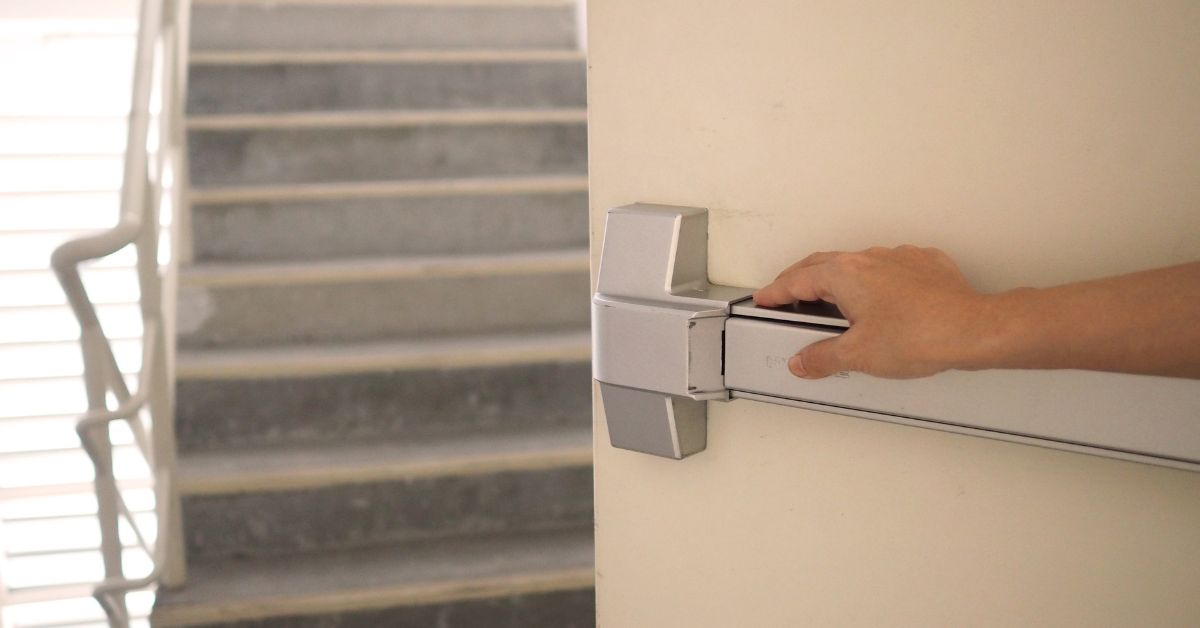Manual vs. Electrified Exit Devices: 5 Key Differences

What Are Exit Devices?
Before we delve into manual and electrified exit devices, you must understand their purpose. Often referred to as “panic bars” or “crash bars,” exit devices are installed on doors to facilitate safe and efficient egress during emergencies.
Typically, exit devices are found in commercial buildings, health-care facilities, schools, and other areas with heavy foot traffic. Their ability to meet strict building codes and enhance occupant safety makes them indispensable in facility management.
Functionality
Manual Exit Devices
Manual exit devices operate solely through mechanical means. When someone pushes the bar, it disengages the latch mechanism, allowing the door to open. These require no power source, making them straightforward and reliable options.
Manual exit devices are simple to install and operate, and they’re reliable even in power outages or emergencies, as they do not depend on electrical infrastructure. However, they lack advanced features such as remote locking and are limited to physical operation. They also cannot integrate with modern security systems.
Electrified Exit Devices
As the name suggests, these devices incorporate electronic components to maximize functionality. They can be connected to a power source and integrated with building security systems like access control or alarm systems. For example, you can enable remote locking and unlocking from a central location, making them ideal for facilities requiring advanced control and high security.
Electrified exit devices support high-tech features like remote access and alarm integration, improving convenience and security in complex buildings. They can also integrate with access control systems for seamless management.
That said, these devices require an electrical source, which may fail during power outages unless a backup power system is in place. In addition, installation may be more complex and time-intensive.

Security Features
While manual exit devices provide a basic level of security, their functionality is limited to locking and unlocking via the physical latch mechanism. This makes them less suitable for facilities that require advanced access controls.
On the other hand, electrified options offer innovative security measures. You can program them to work with access control software, biometric systems, or keycards for greater control over who can enter or exit specific areas. Additionally, some electrified devices can send real-time alerts if unauthorized access is attempted.
Cost Considerations
Manual devices are generally more cost-effective upfront due to their straightforward design and installation process. Since they don’t require integration with electrical systems, they’re a more affordable choice if your building is on a tight budget and doesn’t need advanced security features.
Electrified devices usually cost more initially and in ongoing maintenance. The reason for this is that they require specialized software, wiring, and possibly even professional training for your staff. However, since they offer long-term operational benefits, the added expense might be worthwhile if your facility has complex security or monitoring needs.
Maintenance Requirements
Manual devices have fewer components, making them less prone to malfunctions. Routine checks are usually sufficient to ensure they operate reliably for extended periods. However, they still need occasional maintenance to prevent wear and tear on mechanical parts.
Electrified devices, though more complex, are built with durability in mind. Nevertheless, their electrical components and system integrations may require periodic updates, inspections, and specialized upkeep. For example, you’ll need to maintain intact wiring and functional software to avoid disruptions.
Emergency Preparedness
One of the primary purposes of an exit device is to facilitate quick egress during emergencies such as fires or active threat situations. The way manual and electrified devices enable this differs significantly.

Manual devices perform consistently well in emergencies, as they operate entirely on mechanical force and don’t depend on a power supply. Even if an electrical outage occurs, a manual panic bar will operate flawlessly.
Electrified systems often include fail-safe or fail-secure options to ensure they can respond effectively in the event of an emergency. Fail-safe mode ensures all building occupants can exit quickly. This feature allows doors to unlock automatically in the event of a power failure.Meanwhile, fail-secure mode keeps doors locked when the power is cut, which is ideal for areas needing strict security. However, it may cause issues with egress unless supported by auxiliary backup systems.
This degree of customization adds a layer of complexity but also highlights electrified systems’ adaptability to emergencies.
Versatility and Integration
Manual devices are relatively straightforward and cannot be easily integrated with modern technologies, such as access control systems or alarms. They are better suited for facilities that prioritize simplicity and reliability over tech-savviness.
When it comes to versatility, electrified devices shine. You can integrate them with security systems, building automation controls, and even IoT devices. For example, you can program certain doors to remain locked on weekends or after business hours and receive alerts about unauthorized attempts. With their ability to adapt to advanced technologies, electrified devices are truly a future-ready solution.
Which Exit Device Is Right for Your Building?
Ask yourself the following questions to decide between manual and electrified exit devices:
- What level of security does your building need? If your facility handles sensitive information or valuable goods, electrified devices may be worth the investment.
- How often do you expect maintenance? If you prefer minimal upkeep, manual devices are generally easier to maintain.
- Do you want to integrate with access control systems? Electrified devices offer seamless integration for added convenience and control.
- What is your budget? Manual devices are more budget-friendly, while electrified devices offer long-term functionality for a higher initial cost.
Choosing the right exit device is crucial in streamlining building operations, ensuring occupant safety, and meeting compliance requirements. Be sure to consider your building’s specific needs when deciding.
Enhance Your Facility’s Safety Today
Exit devices may seem like small components in the larger scheme of facility management, but they play essential roles in securing your building and ensuring occupant safety. Now that you understand these five key differences between manual and electrified exit devices, you’re ready to choose the option that meets your needs.
Need help selecting the perfect exit device for your building? Head over to DoorHub, and work with our team of experts to ensure your facility is safe and ready for the future.

Author
Michael Rega
Chief Marketing Officer and founding Member of DoorHub.com